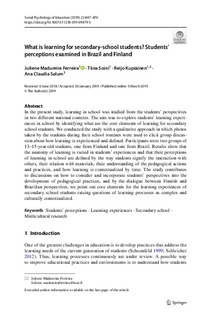| dc.contributor.author | Ferreira, Juliene Madureira | |
| dc.contributor.author | Soini, Tiina | |
| dc.contributor.author | Kupiainen, Reijo P. | |
| dc.contributor.author | Salum, Ana Claudia | |
| dc.date.accessioned | 2019-09-20T06:09:02Z | |
| dc.date.available | 2019-09-20T06:09:02Z | |
| dc.date.created | 2019-03-27T11:19:51Z | |
| dc.date.issued | 2019 | |
| dc.identifier.citation | Social Psychology of Education. 2019, 22 (2), 447-470. | nb_NO |
| dc.identifier.issn | 1381-2890 | |
| dc.identifier.uri | http://hdl.handle.net/11250/2617940 | |
| dc.description.abstract | In the present study, learning in school was studied from the students’ perspectives in two different national contexts. The aim was to explore students’ learning experiences in school by identifying what are the core elements of learning for secondary school students. We conducted the study with a qualitative approach in which photos taken by the students during their school routines were used to elicit group discussion about how learning is experienced and defined. Participants were two groups of 13–15-year-old students, one from Finland and one from Brazil. Results show that the anatomy of learning is varied in students’ experiences and that their perceptions of learning in school are defined by the way students signify the interaction with others, their relation with materials, their understanding of the pedagogical actions and practices, and how learning is contextualized by time. The study contributes to discussions on how to consider and incorporate students’ perspectives into the development of pedagogical practices, and by the dialogue between Finnish and Brazilian perspectives, we point out core elements for the learning experiences of secondary school students raising questions of learning processes as complex and culturally contextualized. | nb_NO |
| dc.language.iso | eng | nb_NO |
| dc.publisher | Springer Verlag | nb_NO |
| dc.rights | Navngivelse 4.0 Internasjonal | * |
| dc.rights.uri | http://creativecommons.org/licenses/by/4.0/deed.no | * |
| dc.title | What is learning for secondary-school students? Students’ perceptions examined in Brazil and Finland | nb_NO |
| dc.type | Journal article | nb_NO |
| dc.type | Peer reviewed | nb_NO |
| dc.description.version | publishedVersion | nb_NO |
| dc.source.pagenumber | 447-470 | nb_NO |
| dc.source.volume | 22 | nb_NO |
| dc.source.journal | Social Psychology of Education | nb_NO |
| dc.source.issue | 2 | nb_NO |
| dc.identifier.doi | 10.1007/s11218-019-09479-5 | |
| dc.identifier.cristin | 1688168 | |
| dc.description.localcode | © The Author(s) 2019 Open Access This article is distributed under the terms of the Creative Commons Attribution 4.0 International License (http://creativecommons.org/licenses/by/4.0/) | nb_NO |
| cristin.unitcode | 194,67,70,0 | |
| cristin.unitname | Institutt for pedagogikk og livslang læring | |
| cristin.ispublished | true | |
| cristin.fulltext | postprint | |
| cristin.qualitycode | 2 | |

